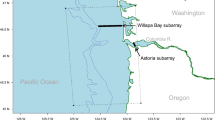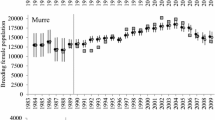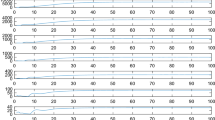Abstract
We continue our efforts in modeling Daphnia magna, a species of water flea, by proposing a continuously structured population model incorporating density-dependent and density-independent fecundity and mortality rates. We collected new individual-level data to parameterize the individual demographics relating food availability and individual daphnid growth. Our model is fit to experimental data using the generalized least-squares framework, and we use cross-validation and Akaike Information Criteria to select hyper-parameters. We present our confidence intervals on parameter estimates.







Similar content being viewed by others
References
Adoteye K, Banks H, Flores KB, LeBlanc GA (2015a) Estimation of time-varying mortality rates using continuous models for Daphnia magna. Appl Math Lett 44:12–16
Adoteye K, Banks HT, Cross K, Eytcheson S, Flores KB, LeBlanc GA, Nguyen T, Ross C, Smith E, Stemkovski M et al (2015b) Statistical validation of structured population models for Daphnia magna. Math Biosci 266:73–84
Adoteye K, Banks HT, Flores KB (2015c) Optimal design of non-equilibrium experiments for genetic network interrogation. Appl Math Lett 40:84–89
Akaike H (1974) A new look at the statistical model identification. IEEE Trans Autom Control 19(6):716–723
Ananthasubramaniam B, Nisbet RM, Nelson WA, McCauley E, Gurney WS (2011) Stochastic growth reduces population fluctuations in Daphnia-algal systems. Ecology 92(2):362–372
Ankley GT, Bennett RS, Erickson RJ, Hoff DJ, Hornung MW, Johnson RD, Mount DR, Nichols JW, Russom CL, Schmieder PK et al (2010) Adverse outcome pathways: a conceptual framework to support ecotoxicology research and risk assessment. Environ Toxicol Chem 29(3):730–741
Baldwin WS, LeBlanc GA (1994) Identification of multiple steroid hydroxylases in Daphnia magna and their modulation by xenobiotics. Environ Toxicol Chem 13(7):1013–1021
Banks H, Davis JL (2007) A comparison of approximation methods for the estimation of probability distributions on parameters. Appl Numer Math 57(5):753–777
Banks HT, Joyner ML (2017) AIC under the framework of least squares estimation. Appl Math Lett 74:33–45
Banks HT, Tran H (2009) Mathematical and experimental modeling of physical and biological processes. CRC Press, Boca Raton
Banks H, Banks JE, Dick LK, Stark JD (2007) Estimation of dynamic rate parameters in insect populations undergoing sublethal exposure to pesticides. Bull Math Biol 69(7):2139–2180
Banks JE, Dick L, Banks H, Stark JD (2008) Time-varying vital rates in ecotoxicology: selective pesticides and aphid population dynamics. Ecol Model 210(1):155–160
Banks H, Davis JL, Ernstberger SL, Hu S, Artimovich E, Dhar AK (2009) Experimental design and estimation of growth rate distributions in size-structured shrimp populations. Inverse Probl 25(9):095003
Banks HT, Hu S, Thompson WC (2014) Modeling and inverse problems in the presence of uncertainty. CRC Press, Boca Raton
Banks HT, Catenacci J, Hu S (2015) Use of difference-based methods to explore statistical and mathematical model discrepancy in inverse problems. J Inverse Ill-posed Probl 24(4):413–433
Banks HT, Everett RA, Hu S, Murad N, Tran HT (2016) Mathematical and statistical model misspecifications in modelling immune response in renal transplant recipients. Inverse Probl Sci Eng 1–18
Baraldi R, Cross K, McChesney C, Poag L, Thorpe E, Flores KB, Banks H (2014) Uncertainty quantification for a model of HIV-1 patient response to antiretroviral therapy interruptions. Technical Report CRSC-TR13-13, Center for Research in Scientific Computation, N C State University, Raleigh, NC, Oct, 2013. In: 2014 American control conference, IEEE, pp 2753–2758
Burnham KP, Anderson DR (2002) Model selection and multimodel inference: a practical information-theoretic approach. Springer, New York
Caswell H (1989) Matrix population models: construction, analysis, and interpretation. Sinauer Associates, Sunderland
Caswell H (ed) (2005) Food webs: from connectivity to energetics. Advances in ecological research, vol 36. Elsevier Academic Press, San Diego
Council NR (2013) Assessing risks to endangered and threatened species from pesticides. The National Academies Press, Washington
Davidian M, Giltinan DM (1995) Nonlinear models for repeated measurement data, vol 62. CRC Press, Boca Raton
de Roos AM, Metz JAJ, Evers E, Leipolt A (1990) A size dependent predator-prey interaction: Who pursues whom? J Math Biol 28(6):609–643
Diekmann O, Gyllenberg M, Metz J (2007) Physiologically structured population models: towards a general mathematical theory. Springer, Berlin
Diekmann O, Gyllenberg M, Metz J, Nakaoka S, de Roos AM (2010) Daphnia revisited: local stability and bifurcation theory for physiologically structured population models explained by way of an example. J Math Biol 61(2):277–318
El-Doma M (2011) Stability analysis of a size-structured population dynamics model of Daphnia. Int J Pure Appl Math 70(2):189–209
El-Doma M (2012) A size-structured population dynamics model of Daphnia. Appl Math Lett 25(7):1041–1044
Ellner SP, Guckenheimer J (2011) Dynamic models in biology. Princeton University Press, Princeton
Ellner SP, Childs DZ, Rees M (2016) Data-driven modelling of structured populations: a practical guide to the integral projection model. Springer, Berlin
Erickson RA, Cox SB, Oates JL, Anderson TA, Salice CJ, Long KR (2014) A Daphnia population model that considers pesticide exposure and demographic stochasticity. Ecol Model 275:37–47
Farkas JZ, Hagen T (2007) Linear stability and positivity results for a generalized size-structured Daphnia model with inflow. Appl Anal 86(9):1087–1103
Finkel DE, Kelley CT (2004) Convergence analysis of the direct algorithm. Optim Online 14(2):1–10
Goser B, Ratte HT (1994) Experimental evidence of negative interference in Daphnia magna. Oecologia 98(3–4):354–361
Hanson N, Stark JD (2011) A comparison of simple and complex population models to reduce uncertainty in ecological risk assessments of chemicals: example with three species of Daphnia. Ecotoxicology 20(6):1268–1276
Keyfitz N, Caswell H (2005) Applied mathematical demography, 3rd edn. Springer, New York
Kooijman SALM, Metz JAJ (1984) On the dynamics of chemically stressed populations: the deduction of population consequences from effects on individuals. Ecotoxicol Environ Saf 8(3):254–274
Kramer VJ, Etterson MA, Hecker M, Murphy CA, Roesijadi G, Spade DJ, Spromberg JA, Wang M, Ankley GT (2011) Adverse outcome pathways and ecological risk assessment: bridging to population-level effects. Environ Toxicol Chem 30(1):64–76
LeBlanc GA, Wang YH, Holmes CN, Kwon G, Medlock EK (2013) A transgenerational endocrine signaling pathway in crustacea. PLoS ONE 8(4):e61715
Leslie PH (1945) On the use of matrices in certain population mathematics. Biometrika 33(3):183–212
Martins JRRA, Kroo IM, Alonso JJ (2000) An automated method for sensitivity analysis using complex variables. In: Proceedings of the 38th AIAA aerospace sciences meeting
McCauley E, Nelson WA, Nisbet RM (2008) Small-amplitude cycles emerge from stage-structured interactions in Daphnia-algal systems. Nature 455(7217):1240–1243
Nelson WA, McCauley E, Nisbet RM (2007) Stage-structured cycles generate strong fitness-equalizing mechanisms. Evol Ecol 21(4):499–515
Nisbet RM, Gurney WSC (1983) The systematic formulation of population models for insects with dynamically varying instar duration. Theor Popul Biol 23(1):114–135
Olmstead AW, LeBlanc GA (2007) The environmental-endocrine basis of gynandromorphism (intersex) in a crustacean. Int J Biol Sci 3(2):77–84
Preuss TG et al (2009) Development and validation of an individual based Daphnia magna population model: the influence of crowding on population dynamics. Ecol Model 220(2):310–329
Rider CV, LeBlanc GA (2005) An integrated addition and interaction model for assessing toxicity of chemical mixtures. Toxicol Sci 87(2):520–528
Rutter EM, Banks HT, LeBlanc G, Flores KB (2016) Continuous structured population models for Daphnia magna. Technical Report CRSC-TR16-16, Center for Research in Scientific Computation, N C State University, Raleigh, NC, Dec
Shampine L (2005) Solving hyperbolic pdes in matlab. Appl Numer Anal Comput Math 2(3):346–358
Sinko JW, Streifer W (1967) A new model for age-size structure of a population. Ecology 48(6):910–918
Wagenmakers E, Farrell S (2004) AIC model selection using Akaike weights. Psychon Bull Rev 11(1):192–196
Wang HY, Olmstead AW, Li H, LeBlanc GA (2005) The screening of chemicals for juvenoid-related endocrine activity using the water flea Daphnia magna. Aquat Toxicol 74(3):193–204
Wang YH, Kwon G, Li H, LeBlanc GA (2011) Tributyltin synergizes with 20-hydroxyecdysone to produce endocrine toxicity. Toxicol Sci 123(1):71–79
Wood S (1994) Obtaining birth and mortality patterns from structured population trajectories. Ecol Monogr 64(1):23–44
Acknowledgements
This research was supported in part by the Air Force Office of Scientific Research under Grant Number AFOSR FA9550-15-1-0298, in part by the National Science Foundation under NSF Grant Number DMS-0946431, and in part by the EPA under US EPA STAR Grant RD-835165.
Author information
Authors and Affiliations
Corresponding author
Electronic supplementary material
Below is the link to the electronic supplementary material.
Rights and permissions
About this article
Cite this article
Rutter, E.M., Banks, H.T., LeBlanc, G.A. et al. Continuous Structured Population Models for Daphnia magna . Bull Math Biol 79, 2627–2648 (2017). https://doi.org/10.1007/s11538-017-0344-8
Received:
Accepted:
Published:
Issue Date:
DOI: https://doi.org/10.1007/s11538-017-0344-8




